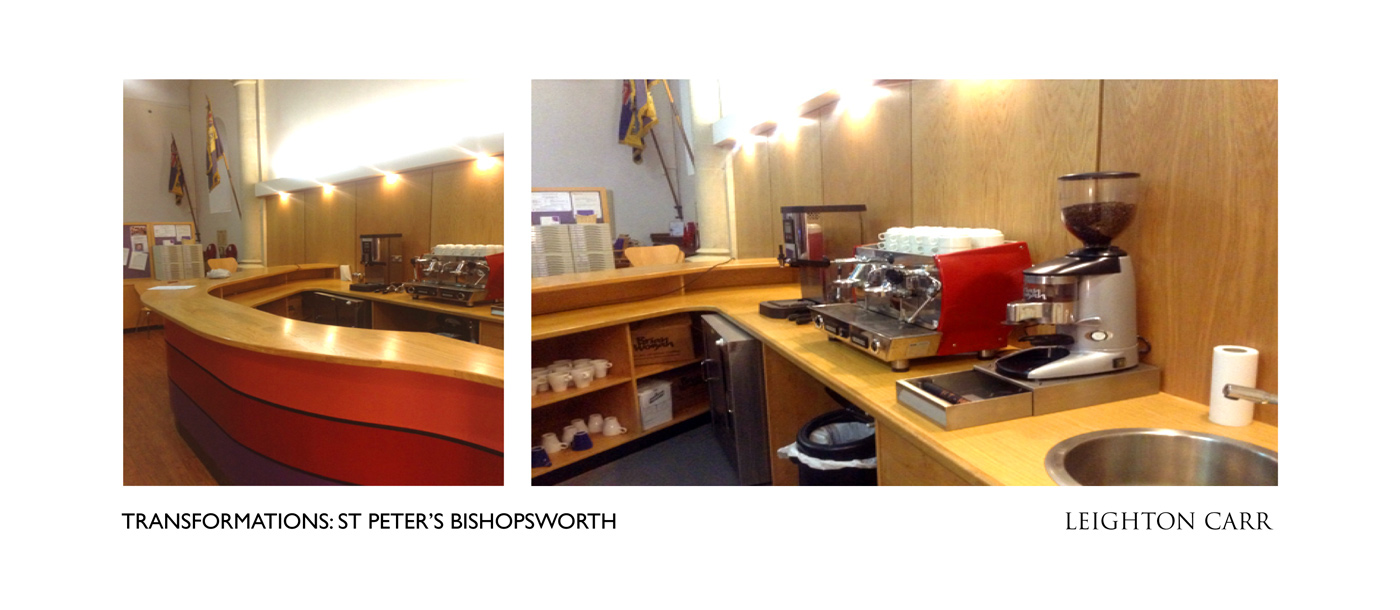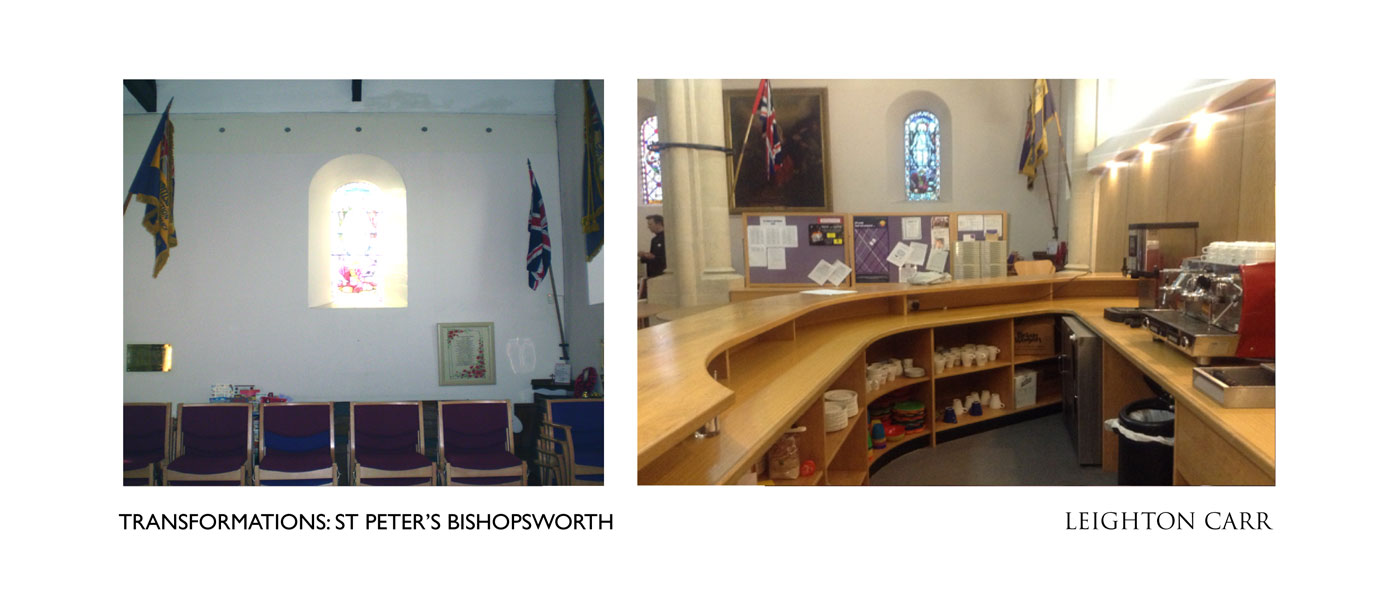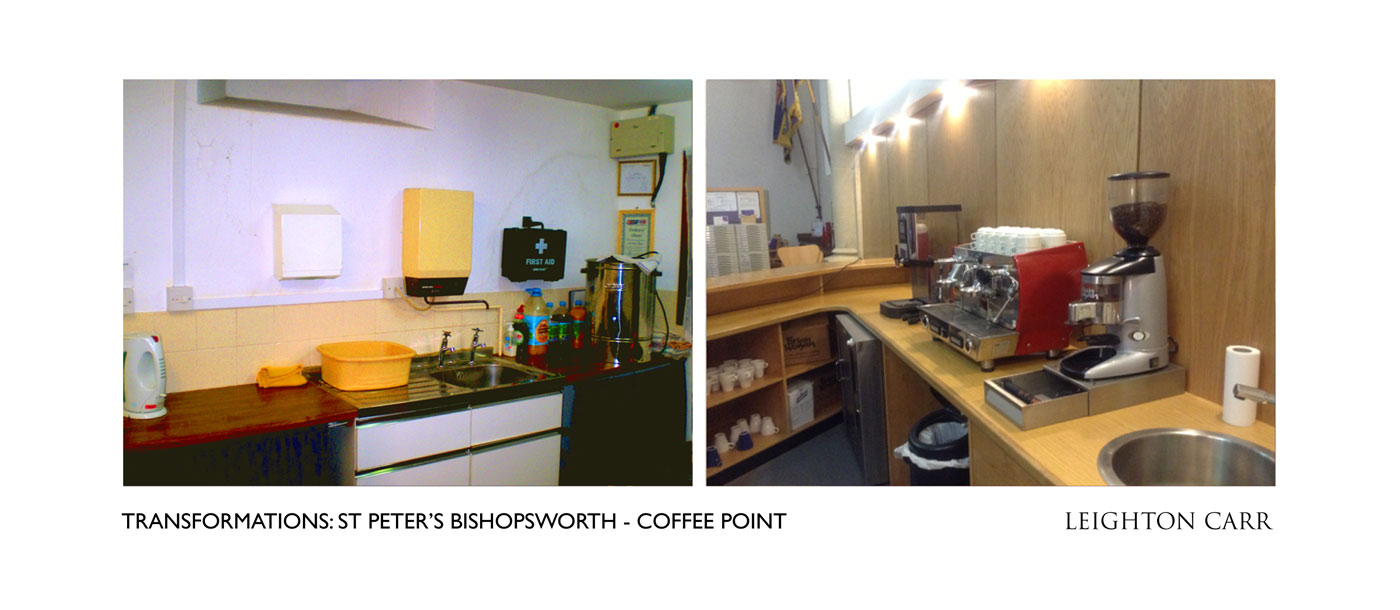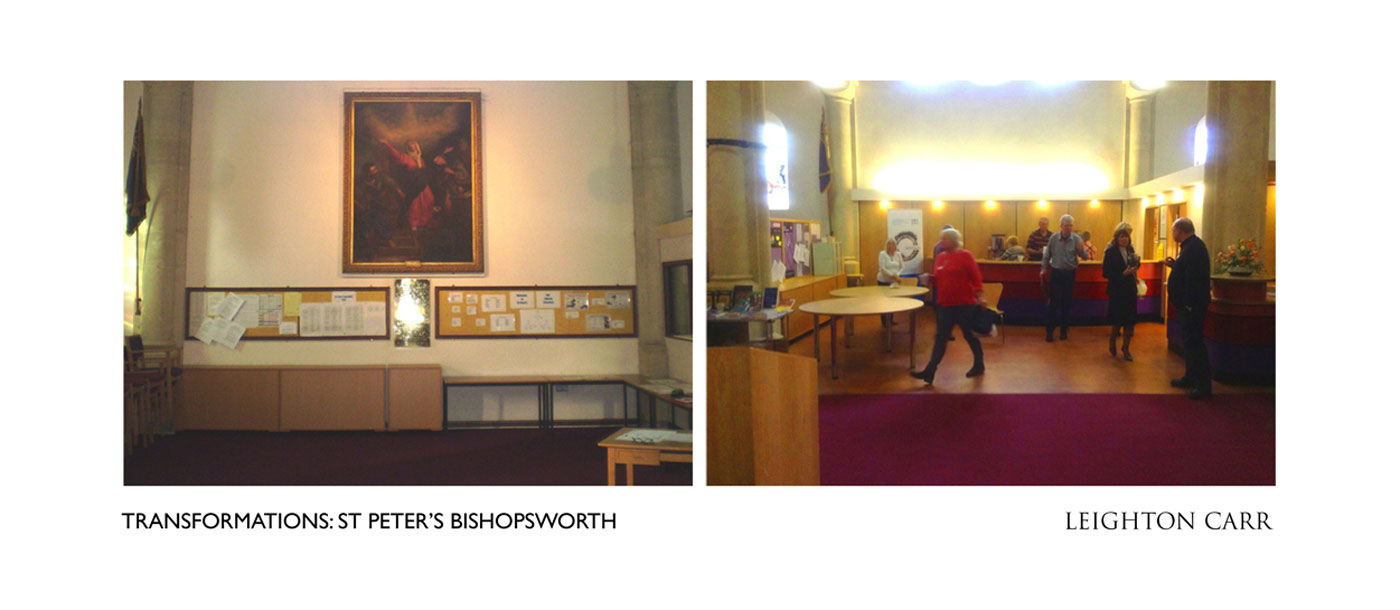Category: creatively re-imagining church
I Imagine …
I Imagine …\n\nA church where people proudly own the name Christian outside its walls\nand proudly act as Christians inside its walls\n\nWhere people proudly give as Christians should\nand proudly serve as Christians should\n\nA church that is not\nawash with mediocrity\nor with sameness done well\n\nA church that does not\nreward competence in mediocre service\nand punish outrageous but courageous failure\n\nBut a church where courage\nand enterprise\nare second nature\n\nAnd the greatest aspiration\ncollectively and personally\nis to serve God\nin the world\nwith all the pride\nand confidence\nof those who live as children of the King.
Transformations: St Peters Bishopsworth (4)
Transformations: St Peters Bishopsworth (3)
Kill it off?
There are churches that are dying. By their own measures they are no longer viable, and by New Testament measures they are no longer Biblical.
\n
So what’s the best thing to do? Kill them off … or give them an injection of sustaining attention?
\n
In business, whole companies and whole departments regularly get culled as part of the shaping and pruning of the company/industry/sector. It’s not unusual, and some people are naturals when it comes to making the difficult decision to close something down. In fact, it’s an essential skill of both leadership and management. Kevin Kelly, guru of the digital age, in his book Out of Control says this:
\n
“It is generally easier to kill an organisation than change it substantially. Organisations by design are not made to adapt … beyond a certain point. Beyond this point it’s much easier to kill them off and start a new one … than it is to change them”
\n
(check out Kevin Kelly on his blog, or his discussion on the future of the internet on TED)
\n
But the church is different.
\n
The church by design was made to grow – continually. What it’s designer had in mind was more of a family than an organisation, with the inherent growth of reproduction built into it’s design. Kelly’s analysis doesn’t apply to a family. The church was meant to be a family that adapts – continually.
\n
So how can individual churches be dying?
\n
Because we turn them from families into organisations made in our own image – and Kelly’s analysis does apply to organisations, “its generally easier to kill an organisation than the change it substantially”.
\n
So sometimes we are faced with a choice. We may have to kill off the organisation to rediscover the family. If we don’t, in some places we will guarantee losing both.
\n
But really, who has the courage for that?
\n
Doing Matters
Strategy + Inaction = A Waste of Time
\n
&
\n
Action + Chaos = A Waste of Effort
\n
\n
So apart from occasional pot luck successes it’s better to have
\n
\n
Strategy + Action = Rewarded Success
\n
\n
But if it’s a choice between
\n
Thinking Some More
\n
and
\n
Doing Some More
\n
there has to be a pretty good reason not to just
\n
START SOMETHING
\n
Transformations: St Peters Bishopsworth Bistro (2)
Transformations: St Peters Bishopsworth Bristol (1)
Junior leaders in Senior posts
There’s a conundrum built into the process of renewing small Church of England congregations in urban and suburban areas. It’s centred on inexperience verses experienced leadership.\r\n\r\nWhen Curates finish their training they need to move to manageable congregations as a Post of First Responsibility.\r\n\r\nLarge churches are inappropriate environments for inexperienced incumbents. There’s to much at stake. Which leaves small churches. To be specific, this year’s curates have been advised that a an appropriate church for a first post is not more than 140 people give or take.\r\n\r\nBut smaller churches often have inherent problems such as …\r\n
- \r\n
- Few resources and a weak asset base …
- Debts, bad buildings and other liabilities
- An over-stretched but disillusioned minority keeping the church alive
- A demanding uncommitted congregation with unrealistic expectations
- A shortage of trained lay people and very few competent ministries
- Power problems, authority issues and personality clashes
- Unwillingness of the diocese to fund small failing churches
\r\n
\r\n
\r\n
\r\n
\r\n
\r\n
\r\n
\r\nIs this a job for a newly trained incumbent fresh from a curacy? For some characters maybe yes, they would thrive on this, but they are probably in the minority. What many of these churches really require is a more experienced person to guide them into renewal and make them effective. Someone who already has experience of leading congregations into growth, dealing with difficult characters, used to backing themselves in a conflict, able to build trust through times of hardship.\r\n\r\nBut here is the second problem. Small churches don’t attract the best and most experienced clergy.\r\n\r\nThis leadership conundrum raises two questions:\r\n
- \r\n
- how do small churches obtain the right person to bring renewal?
- where should new incumbents work if they are to become effective leaders and not be overwhelmed?
\r\n
\r\n
\r\nThe team ministry may offer a solution. Rather than being seen only as a way of saving salaries, one of the strengths of the team ministry is that it offers scope for involvement of clergy of various levels of expertise and experience. Large churches know this already and often they operate as a collection of ministries under the banner of a church rather than a benefice.\r\n\r\n(PS Is this only specific to urban churches? Possibly not, but different factors affect rural churches and chaplaincies)
Harvard Oxymoron – Creating an Organic Growth Machine
The Harvard Business Review audio library is a great resource and one I use regularly. Over the years it has been an invaluable source of ideas on organisations and personal development (explore at http://hbr.org/multimedia).
\n
But I was puzzled by the title of an interview given by Ken Favaro called ‘Creating an Organic Growth Machine’ (listen here – it’s worth it).
\n
The material was fine, and led me to rethink the way we could approach the funding of Pioneer Ministry in the Church of England (see the posts starting with Problems with Pioneers – Revex v Capex Funding). It was the oxymoron embedded in the title that caught my attention.
\n
Organic. Growth. Machine.
\n
Machines don’t grow organically. At least not the ones I’ve dealt with.
\n
For example, I analysed the shop floor layouts of the production lines at Transtec PLC in Coventry to see how we could reorganise the machines that produce aluminium engine parts for Jaguar cars. And another time I examined the machines that produce aluminium extrusions in a factory in Holland to ensure we could achieve the shapes and finishes we needed on a glazing contract.
\n
Obviously there was no possibility that these machines could exhibit any signs of organic growth.
\n
I knew what Ken Favaro was getting at. It was the idea that in some way we can combine two ideas into one image to give us a model for organisational development: combining the idea of a well ordered, machined process with the idea of organic growth in the natural world.
\n
The problem when we combine these two images is when we ‘drill down’ (there’s an irony, using an image borrowed from the oil and gas industry) into the metaphor. For example, we treat machines in a very different way from nature.
\n
- \n
- We tweak machines; we prune plants.
- We maintain machines; we nurture plants.
- We plan for obsolescence in machines; we allow for re-generation in plants.
- We drive machines for maximum consistent production: we tend plants for seasonal fruitfulness.
\n
\n
\n
\n
\n
There’s a “So what?” about all this? Does it matter? It’s just an idea.
\n
Well, I think it does. The images we overlay on our organisations can set the language, the pace, the values, the expectations, and the measures of success. Care is needed when handling powerful images, and it takes a high level of leadership skill to shape metaphors and images into a strong coherent narrative that doesn’t disenfranchise the true resource of the organisation – the people around whom it is built and sustained.
\n




